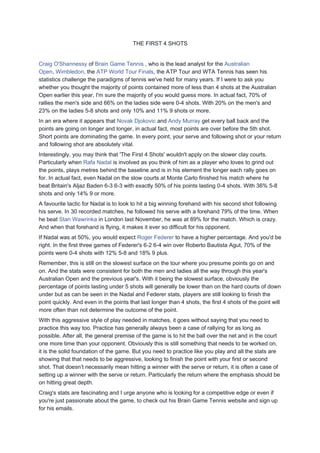Recommended
Recommended
More Related Content
Featured
Featured (20)
Product Design Trends in 2024 | Teenage Engineerings

Product Design Trends in 2024 | Teenage Engineerings
How Race, Age and Gender Shape Attitudes Towards Mental Health

How Race, Age and Gender Shape Attitudes Towards Mental Health
AI Trends in Creative Operations 2024 by Artwork Flow.pdf

AI Trends in Creative Operations 2024 by Artwork Flow.pdf
Content Methodology: A Best Practices Report (Webinar)

Content Methodology: A Best Practices Report (Webinar)
How to Prepare For a Successful Job Search for 2024

How to Prepare For a Successful Job Search for 2024
Social Media Marketing Trends 2024 // The Global Indie Insights

Social Media Marketing Trends 2024 // The Global Indie Insights
Trends In Paid Search: Navigating The Digital Landscape In 2024

Trends In Paid Search: Navigating The Digital Landscape In 2024
5 Public speaking tips from TED - Visualized summary

5 Public speaking tips from TED - Visualized summary
Google's Just Not That Into You: Understanding Core Updates & Search Intent

Google's Just Not That Into You: Understanding Core Updates & Search Intent
The six step guide to practical project management

The six step guide to practical project management
Beginners Guide to TikTok for Search - Rachel Pearson - We are Tilt __ Bright...

Beginners Guide to TikTok for Search - Rachel Pearson - We are Tilt __ Bright...
THE FIRST 4 SHOTS
- 1. THE FIRST 4 SHOTS Craig O'Shannessy of Brain Game Tennis , who is the lead analyst for the Australian Open, Wimbledon, the ATP World Tour Finals, the ATP Tour and WTA Tennis has seen his statistics challenge the paradigms of tennis we've held for many years. If I were to ask you whether you thought the majority of points contained more of less than 4 shots at the Australian Open earlier this year, I'm sure the majority of you would guess more. In actual fact, 70% of rallies the men's side and 66% on the ladies side were 0-4 shots. With 20% on the men's and 23% on the ladies 5-8 shots and only 10% and 11% 9 shots or more. In an era where it appears that Novak Djokovic and Andy Murray get every ball back and the points are going on longer and longer, in actual fact, most points are over before the 5th shot. Short points are dominating the game. In every point, your serve and following shot or your return and following shot are absolutely vital. Interestingly, you may think that 'The First 4 Shots' wouldn't apply on the slower clay courts. Particularly when Rafa Nadal is involved as you think of him as a player who loves to grind out the points, plays metres behind the baseline and is in his element the longer each rally goes on for. In actual fact, even Nadal on the slow courts at Monte Carlo finished his match where he beat Britain's Aljaz Baden 6-3 6-3 with exactly 50% of his points lasting 0-4 shots. With 36% 5-8 shots and only 14% 9 or more. A favourite tactic for Nadal is to look to hit a big winning forehand with his second shot following his serve. In 30 recorded matches, he followed his serve with a forehand 79% of the time. When he beat Stan Wawrinka in London last November, he was at 89% for the match. Which is crazy. And when that forehand is flying, it makes it ever so difficult for his opponent. If Nadal was at 50%, you would expect Roger Federer to have a higher percentage. And you'd be right. In the first three games of Federer's 6-2 6-4 win over Roberto Bautista Agut, 70% of the points were 0-4 shots with 12% 5-8 and 18% 9 plus. Remember, this is still on the slowest surface on the tour where you presume points go on and on. And the stats were consistent for both the men and ladies all the way through this year's Australian Open and the previous year's. With it being the slowest surface, obviously the percentage of points lasting under 5 shots will generally be lower than on the hard courts of down under but as can be seen in the Nadal and Federer stats, players are still looking to finish the point quickly. And even in the points that last longer than 4 shots, the first 4 shots of the point will more often than not determine the outcome of the point. With this aggressive style of play needed in matches, it goes without saying that you need to practice this way too. Practice has generally always been a case of rallying for as long as possible. After all, the general premise of the game is to hit the ball over the net and in the court one more time than your opponent. Obviously this is still something that needs to be worked on, it is the solid foundation of the game. But you need to practice like you play and all the stats are showing that that needs to be aggressive, looking to finish the point with your first or second shot. That doesn’t necessarily mean hitting a winner with the serve or return, it is often a case of setting up a winner with the serve or return. Particularly the return where the emphasis should be on hitting great depth. Craig's stats are fascinating and I urge anyone who is looking for a competitive edge or even if you're just passionate about the game, to check out his Brain Game Tennis website and sign up for his emails.
